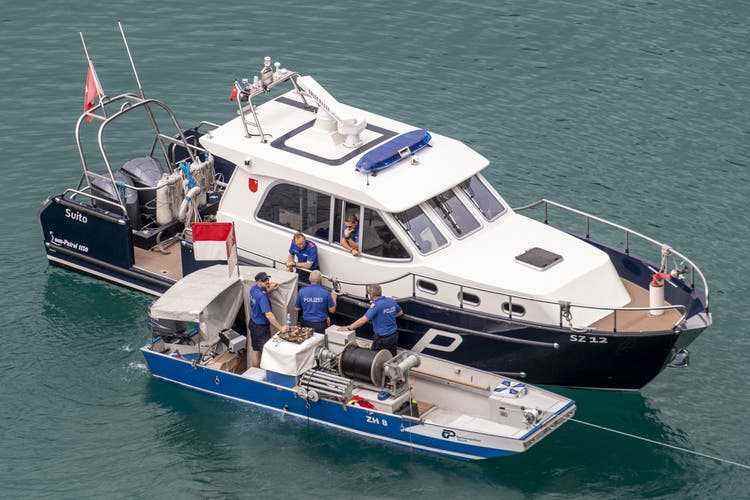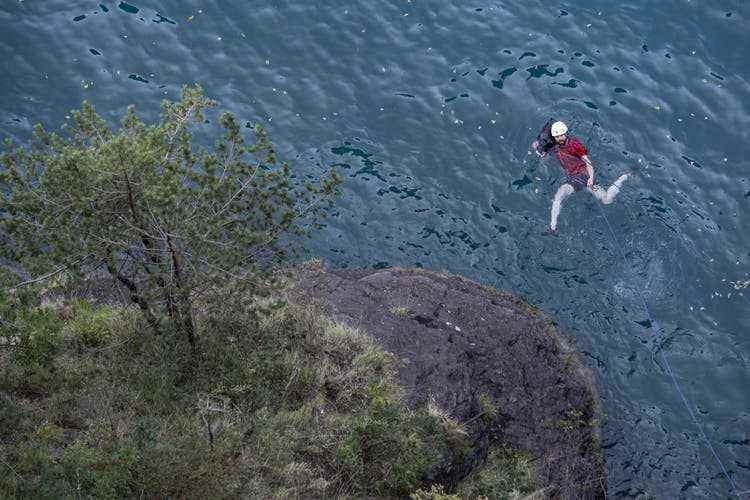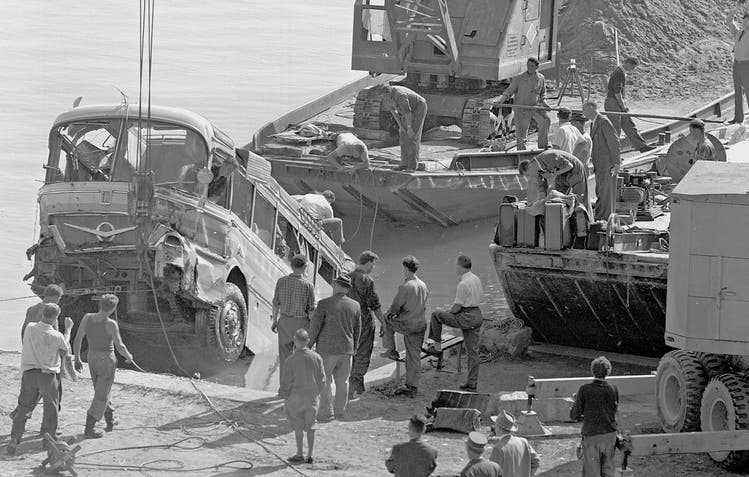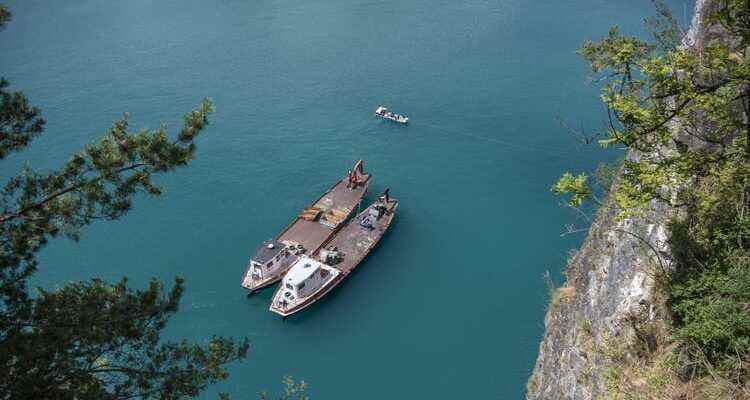Two days after the accident on Axenstrasse, specialists used a camera to locate the sunken car on the bottom of Lake Lucerne. It will take some effort to recover the vehicle from a depth of 182 meters.
Two salvage ships at the scene of the accident on Axenstrasse, where a car left the road when it wolf jumped.
It’s a difficult search, and what the specialists were hoping to find, they probably prefer not to see at all: On Tuesday, an underwater camera from the Zurich cantonal police located the vehicle that had sunk two days earlier on the bottom of Lake Lucerne. The car with a Zurich number plate touched the rock face on the right-hand side during the so-called wolf jump on Axenstrasse on Sunday. It got into the oncoming lane, broke through a railing and fell into the water after 45 meters.
The lake, 180 meters deep at this point, swallowed the vehicle. And with it the hope of survivors. It is not even clear how many people were in the car. The Schwyz canton police could not provide any information on Tuesday afternoon. The investigation into the cause of the accident is still ongoing. Until the results are available, the maximum speed on Axenstrasse is 60 kilometers per hour.
As Richard Kocherhans from the Federal Roads Office (Astra) explains, the authorities are now examining other options to make the route safer in the short term. For example, a permanent speed reduction or the – undeniably expensive – construction of support pillars below the sidewalk hanging in the air at the accident site, the portability of which is already limited today, could be considered. The greatest danger, as Kocherhans makes clear, is not an accident like the one on Sunday, but natural hazards such as falling rocks. Only with the New Axenstrasse project, which is currently blocked in court, is “a really safe Axenstrasse” possible, said Kocherhans at the scene, where traffic was rushing north and south on Tuesday.
Preparations for the salvage are underway
Some people slow down and peer curiously at the barrier tape. Directly behind it is a clear view of the idyllic blue lake on which the police boats go about their less idyllic work. The footage from the depths now provides them with the information they need to be able to salvage the car. The Geneva Maritime Police is a specialist in this discipline. She has various gadgets and robots to find and recover both wrecks and human bodies underwater. At a depth of more than 95 meters, it is not possible to deploy police divers, says Silvain Guillaume-Gentil, media spokesman for the Geneva cantonal police. For a depth of this magnitude, you need an underwater robot that can grab objects with its pincers or attach a carabiner.
Search at a comparable depth in Lake Zug was successful
It is not yet clear how the car – about which the police are currently not providing any further information – will be lifted to the surface. Florian Grossmann, spokesman for the Schwyz canton police, assumes that the salvage will be carried out with the material from the Zurich canton police boat. In other words, the use of the Geneva robot is currently not up for discussion. The goal now is to pull the car to a height where the police divers can get a closer look. The police spokesman said in the afternoon whether that would still be possible today is an open question. Just like the schedule, the question of costs is still unresolved. In the early evening, as later became apparent, the work had to be stopped and postponed to Wednesday morning.
How a rescue can be carried out was shown last autumn in Lake Zug. At the beginning of October 2021, a man sank with his motorboat near Walchwil. Lake Zug is around 200 meters deep at the scene of the accident. At that time, specialists from the Zurich cantonal police searched the bottom of the lake with a sonar probe lowered from the boat. In this way, the murky waters could be scanned on a monitor – with success.

The police boats of Kapo Zurich (left) and the cantonal police of Schwyz during the search operation.

A policeman swims back into the police boat after collecting small pieces of debris on the rock.
After several hours of precision work, specialists from the Geneva Maritime Police were able to attach a rope to the boat with a remote-controlled underwater robot and slowly pull it to the surface. After ten days, the ship with the missing person was recovered in Lake Zug. In terms of depth, this case is comparable to that on Axenstrasse, says Judith Aklin from the Zug police. It was not an everyday operation for the Zug police: “Recovering the motorboat from Lake Zug was very demanding and took a few days,” says Aklin.
In 1961 a bus sank in Lake Lucerne
In this case, too, Florian Grossmann assumes that the campaign will take at least several hours or even days. Likewise, that public interest remains high. No sooner had the news spread that the car had been located on Tuesday afternoon than onlookers gathered at the Wolfsprung rest area, some fascinated, others shocked, some equipped with binoculars. However, the attraction of spectacular accidents is by no means a new phenomenon.

The car is salvaged days after the accident – early in the morning so that as few onlookers as possible disturb it.
When a sunken bus was recovered between Hergiswil and Stansstad in 1961, this was done early in the morning so that as few onlookers as possible would disturb it. At that time, a bus collided with a truck on the Lopper, ripped off the railing on the bank over a distance of almost 20 meters and landed in the lake – it was the worst traffic accident on Swiss roads at the time. The wreck was initially still floating on the water surface, 22 people could be rescued before it went under. 16 tourists from the USA did not manage to free themselves. They died in the accident, most of them by drowning. When the bus was lifted from a depth of 51 meters three days after the accident, the lake released eleven bodies with it. Five people could not be found.
This can be an additional burden for family members. “It is always very important for the families that the body of the deceased can be recovered and handed over to them for the farewell ceremony, as this greatly facilitates the mourning phases,” says Silvain Guillaume-Gentil, media spokesman for the Geneva cantonal police. Although the Schwyz police have not yet given any information about the victims, Florian Grossmann assured that the relatives had been informed.
As difficult as it may be to salvage and deal with what one hopes to find and what one fears, the uncertainty is often even more unbearable.
